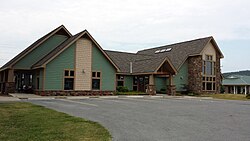Elkins, Arkansas | |
|---|---|
 Elkins City Administration Building | |
 Location of Elkins in Washington County, Arkansas. | |
| Coordinates: 36°01′02″N94°01′30″W / 36.01722°N 94.02500°W | |
| Country | United States |
| State | Arkansas |
| County | Washington |
| Area | |
• Total | 3.91 sq mi (10.13 km2) |
| • Land | 3.87 sq mi (10.03 km2) |
| • Water | 0.04 sq mi (0.10 km2) |
| Elevation | 1,224 ft (373 m) |
| Population (2020) | |
• Total | 3,602 |
• Estimate (2024) | 4,025 |
| • Density | 929.79/sq mi (359.00/km2) |
| Time zone | UTC-6 (Central (CST)) |
| • Summer (DST) | UTC-5 (CDT) |
| ZIP code | 72727 |
| Area code | 479 |
| FIPS code | 05-21190 |
| GNIS feature ID | 2403555 [2] |
| Website | www |
Elkins is a city in Washington County, Arkansas, United States. The community is located in the Boston Mountains, deep in the Ozark Mountains. A combination of the former unincorporated communities of Harris and Hood, Elkins was established in 1964. Located immediately east of Fayetteville in the Northwest Arkansas metropolitan statistical area, Elkins has been experiencing rapid growth in recent years, doubling in population between the 2000 and 2010 censuses. [3]




